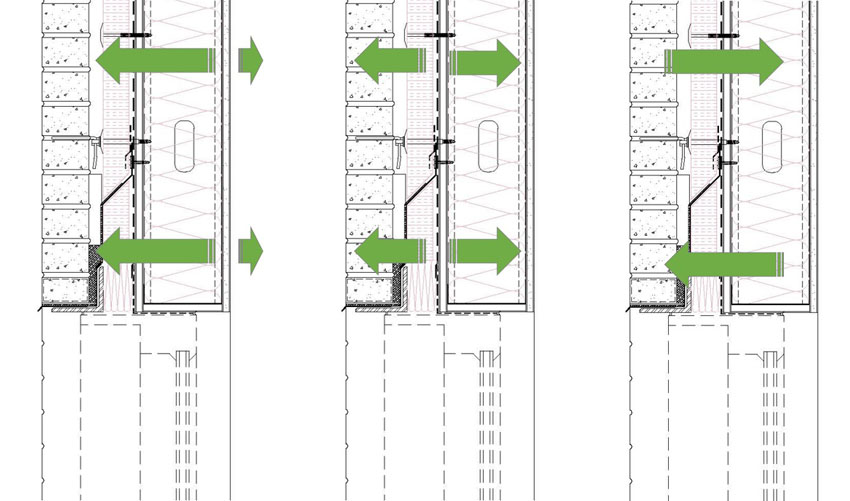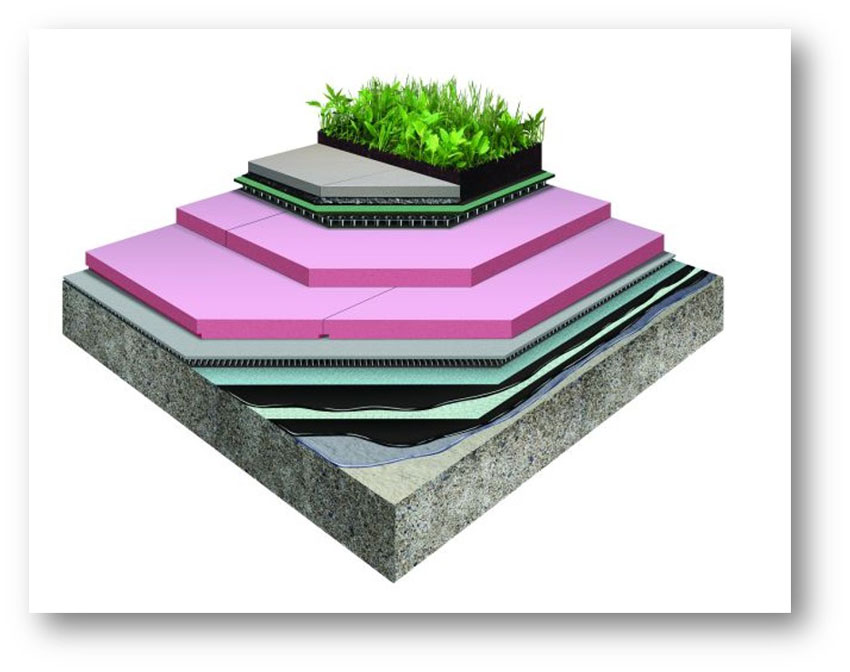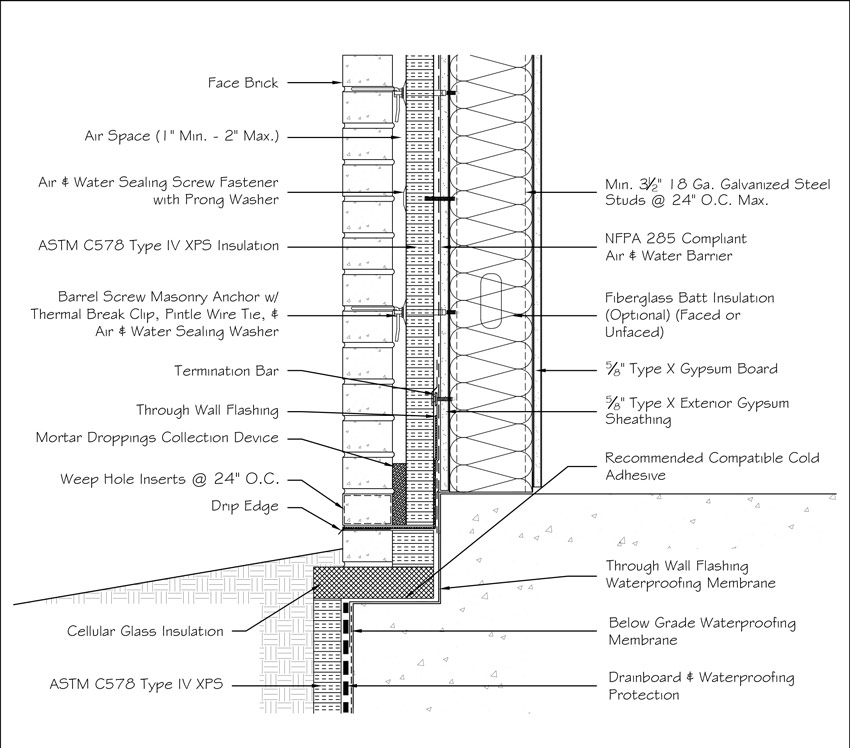The Role of Insulation in Mission-Critical Design
A Note about Vapor Permeability
Vapor permeability describes a material’s ability to allow water vapor to pass through it and it is measured in perms. Perms, roughly, quantifies a rate of vapor diffusion, an amount of moisture that can pass through a barrier in a certain amount of time. The lower the perm value, the better a material is at restricting the movement of water vapor. Materials with very low perm values are considered vapor barriers. The International Building Code (IBC) uses ASTM E96 Method A to categorize materials as vapor retarders. For example, according to the 2018 IBC:
Vapor-Retarder Classification
Class I: 0.1 perm or less
Class II: 0.1 < perm ≤ 1.0 perm
Class III: 1.0 < perm ≤ 10 perm
Vapor-permeable materials are identified as having a minimum permeability of 5 perms per IBC. Materials with a perm rating greater than 10 are considered a permeable material, which means that liquids and vapors easily pass through. Mineral wool continuous insulation is tested around 50 perms depending upon the specific product, indicating that the material has a high vapor permeability and allows a considerable amount of water vapor to pass through it. This creates the opportunity for quite a bit of design flexibility. A vapor barrier could be included on the interior of the wall and mineral wool continuous insulation in the exterior wall cavity would not stop other vapor from escaping; or a vapor barrier could be placed on the exterior sheathing (as the air barrier) and mineral wool would not negatively impact vapor diffusion; or lastly, the entire wall could be constructed without a vapor barrier and mineral wool, with its high vapor permeability, would continue to contribute to vapor diffusion. This ability to fit into multiple wall designs allows for design flexibility when mission-critical buildings need to be adapted for use without concern of trapping vapor.

Because mineral wool does not act as the vapor retarder, a designer has the flexibility of integrating a vapor retarder on the interior wall, exterior wall, or not at all.
On the other hand, cellular glass has a high vapor impermeability, which means it limits the movement of vapor well. Tested at 0 perms per ASTM E96, cellular glass is a Class I solution and an optimal match for applications where there are components that are highly susceptible to moisture damage. Cellular glass can also be used to control humidity levels, which can lead to the downsizing of heating and air-conditioning (HAC) units, as less humidity would need to be removed from (or added to) the indoor air to reach the same comfort levels. This vapor-impermeable quality can create a strong, redundant barrier to moisture vapor in roofs. It also serves as a protective barrier for some vapors aside from just water—although anticipated fumes or other irritants should be analyzed on a case-by case basis to identify a vapor retarder’s ability to prevent their intrusion.
Compressive Strength
The compressive strength of an insulation is the ability to resist an applied load without a specified deflection. Deflection is measured along a graphed curve of deformation of the product related to increase in load and is often reported in percentage of deformation of the total product compared to the load applied. While deflection may occur without failure, the higher the compressive strength, the greater the resistance to a load with less deformation. This resistance to compressive loads is critical in multiple applications throughout the mission-critical building envelope from foundations to walls to roofs.
Many roofs and their components are required to resist surprisingly high loads, including dead loads, live loads, wind loads, soil loads, snow loads, rain loads, flood loads, and even earthquake loads. Dead load is defined by the IBC as the weight of materials of construction incorporated into the building, including but not limited to walls, floors, roofs, ceilings, stairways, built-in partitions, finishes, cladding, and other similarly incorporated architectural and structural items, and the weight of fixed service equipment, such as cranes, plumbing stacks and electrical feeders, heating, ventilating and air-conditioning systems, and automatic sprinkler systems. Per IBC, a live load is the load produced by the use and occupancy of the building or other structure that does not include construction or environmental loads, such as wind load, snow load, rain load, earthquake load, flood load, or dead load. On roofs, a live load is a load produced:
- during maintenance by workers, equipment, or materials;
- during the life of the structure by movable objects such as planters or other similar small decorative appurtenances that are not occupancy related; or
- by the use and occupancy of the roof, such as for roof gardens or assembly areas.
All of these loads exerted on the roof assembly must be safely resisted and may be more extreme for mission-critical buildings, such as in the case of heavy rooftop units for medical facilities, increased wind loads in hurricane-prone regions, and snow loads for extreme northern climates.
Vegetative and paver roofs have historically been a strategy for long-term roof protection. In these protected membrane assemblies (PRMAs), the waterproofing membrane is buried beneath layers of insulation, drainage assemblies, pavers, and growing media, which serves as protection from sun, freeze-thaw cycling, foot traffic, and water. This requires the insulation, placed above the membrane to be highly moisture resistant while retaining thermal value and exhibiting high compressive strength, as the overburden is often very heavy to combat wind-uplift forces.

XPS insulation is placed above the waterproofing membrane in a protected roof membrane assembly, such as the vegetative roof shown here. This product is required to resist moisture and the loads of overburden.
A traditional and highly successful solution for this application has been extruded polystyrene insulation (XPS), which has the highest compressive strength and resistance to moisture absorption of foam plastic board insulations. Polystyrene insulation is categorized into types based on physical properties such as compressive strength according to ASTM C578: Standard Specification for Rigid, Cellular Polystyrene Thermal Insulation. Type V insulation has the highest compressive strength with a minimum of 100 psi. Generally, this meets or exceeds the needs of basic vegetative roof or paver roof assemblies.
But what if a mission-critical building needs more? Where foam plastics leave off, cellular glass picks up with higher compressive strength and even more moisture resistance as previously discussed. For roofs anticipating even greater weights from vehicular traffic, such as fire-rescue equipment or specialized machinery, cellular glass reaches compressive strengths exceeding 100 psi. Similar to the various types of polystyrene insulations defined by ASTM C578, cellular glass products are classified into grades according to ASTM C552: Standard Specification for Cellular Glass Thermal Insulation. (It should be noted that while the current ASTM C552 standard is used, a new standard is being proposed to differentiate cellular glass used for industrial applications as described in ASTM C552 and for construction applications in the new proposed standard.) Products are organized into grades based upon performance properties. Grade 24 requires the highest tested compressive strength at a minimum of 240 psi. It should be noted that the compressive strength of the product is tested with the waterproofing membrane applied or “capped” on top of the surface for a more accurate representation of the compressive performance.

Its compressive strength allows cellular glass to be used to provide insulation where there was previously no solution, like at the foundation of exterior walls where the insulation is in contact with the continuous below-grade insulation along the foundation or slab edge.
Because cellular glass can withstand loads that crush other materials, this product may be used to provide insulation where there was previously no solution for continuous insulation. An example of this is at the foundation of exterior walls where exterior continuous insulation on the wall would ideally be placed in contact with continuous below-grade insulation along the foundation or slab edge. Unfortunately, the heavy stone or masonry veneer would bear on a masonry ledge and at that location, traditional exterior continuous insulations could not withstand such high compressive loads. However, as mentioned above, cellular glass insulation provides a solution to this conflict between continuous load path and continuous insulation path, eliminating the nagging thermal bridge at many exterior foundations. For mission-critical walls, this potentially ensures more energy efficiency and less risk of moisture or condensation at this thermal-bridge location.
Compressive strength can also provide a very different opportunity for mission-critical buildings when used for exterior wall applications. The IBC defines continuous insulation as an insulating material that is continuous across all structural members without thermal bridges other than fasteners and service openings installed on the interior or exterior, or as integral to any opaque surface of the building envelope. Over the past decade, ASHRAE 90.1 and the IECC have begun to require continuous insulation across most building envelopes. As more rigid insulation was placed into the exterior wall cavity where continuity was easier to achieve with less structural and other building component obstacles, more focus has been placed on cladding attachment systems that continue to reduce the penetrations, or thermal bridging, through the continuous insulation.
This has evolved into applications whereby the cladding attachment system is fastened outside of the continuous insulation, completely in the exterior wall cavity, with only screws or fasteners penetrating the actual continuous insulation to return back to the structural stud system. This application, however, relies upon insulation materials that exhibit high compressive strength. Some mineral wool continuous insulation products have been engineered to retain such high compressive strength as to support this type of cladding attachment while retaining the other attributes and benefits of mineral wool. The fire properties of mineral wool allow combustible claddings to be adhered to mission-critical buildings.









